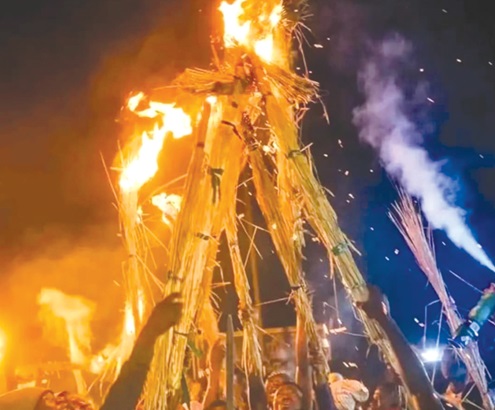
Fire, Fire, Fire! Mole-Dagbani celebrates Bogum Festival
Descendants of the Mole-Dagbon Kingdom comprising Mamprusis, Dagombas, Nanumbas and Mossis across Northern Ghana last Tuesday celebrated the annual Bugum (Fire) Festival with an impressive display of their rich cultural heritage.
The celebration of the time-tested festival was led by the Overlords and chiefs in the various traditional areas. It was observed peacefully into the wee hours of Tuesday and was witnessed by a large number of people, including politicians and some foreign tourists.
With lighted torches and machetes raised above their sweaty bodies and talismans and various kinds of animals’ tails dangling on their arms and waists, the ecstatic men and women danced energetically deep into the night.
Also a delight to watch was how children and women fully adorned in their traditional apparels participated in the celebration. The festival is a significant historical event on the Mole-Dagbani lunar calendar, where the celebrants go on a procession through principal streets, amid drumming, singing and dancing to popular local songs and firing of muskets.
The high point of the festival is at the palaces of chiefs where rituals are performed to signify the commencement of the festival.
History
History has is it that the commemoration of the festival began after the son of a great king in ancient Mole-Dagbani Kingdom went missing and the entire community was dispatched to search for him in the night with torches, amid drumming and dancing.
After a thorough search, the volunteers found the prince deeply asleep under a tree and took him to the eminent king’s palace. However, the king, out of dismay, declared the tree as evil for taking his son away.
Individuals who helped in the search for the prince were made to throw their lighted torches at the ‘evil tree’ in order to shame it, and the king set the day for celebration. Another school of thought has it that, the annual festival derived its source from Islam and is celebrated on the night of the ninth day of the Islamic month of Muha-ram, which is the first month of the Islamic lunar calendar and marks the beginning of the year.
It is also said that the Bugum Festival signifies the victory of Prophet Moses over Pharaoh and God’s blessing on Prophet Noah for the smooth sailing of His ark.
Activities
During the period of the festival, people buy animals to pacify their gods and strengthen their spiritual powers. Usually, the celebration begins about three days to the climax of the festival which is celebrated at night.
On the day of the event, they gather at the palace of their respective chiefs for them to light the first thatch, after which they join in the fire lighting jamboree. The lighted thatches are finally disposed of in a thicket.
Those who cannot resist the thunderous beating of the gong-gong drums (ziem), join the revellers to dance away the night amid the incessant firing of muskets and fireworks.
Significance
Explaining the significance of the festival in an interview with the Daily Graphic, a traditional historian, Badigamsira Inusah Abdul-Majeed, said the Bugum month marked the beginning of the year according to Mole-Dagbani descendants.
He indicated that a day after the festival, the Imam would go to the palace of the king and the various chiefs in the kingdom to perform a ritual called “Sabri Lɔrigi” and prophesy what would happen in the ensuing year.
“The ‘Sabri Lɔrigiri’ is very important in our culture because the Imam will prophesy what will happen in the ensuing year and also tell the king/chief the supplications that will be made for the progress of the kingdom to prevent any plaque from befalling the kingdom,” he said.
Alhaji Abdul-Majeed noted that though there were several narrations regarding the history of the festival, the people of Mole-Dagbani were stuck to that of the missing son of the king.
Tourism potential
Each year, revellers and people from all walks of life often travel to the northern part of the country, particularly Dagbon and Mamprugu, to witness the exciting festival.
Given the rich history and the euphoria that characterise the celebration of the festival, Alhaji Abdul-Majeed emphasised the need for authorities to take a critical look at how they could brand the festival to boost tourism in the area.
At the various palaces, the chiefs called for peace and unity among all the people, admonishing them to be worthy ambassadors of the great ancient kingdom wherever they found themselves.
Some residents who witnessed the celebration told the Daily Graphic that the event reminded them of the rich culture, struggles and tradition of their ancestors. A celebrant, Adam Mustapha, said “it is a good feeling to be part of the celebration because we get to reconnect with our ancestors while preserving the rich cultural heritage.”
Writer’s email: mohammed.fugu@
graphic.com.gh
